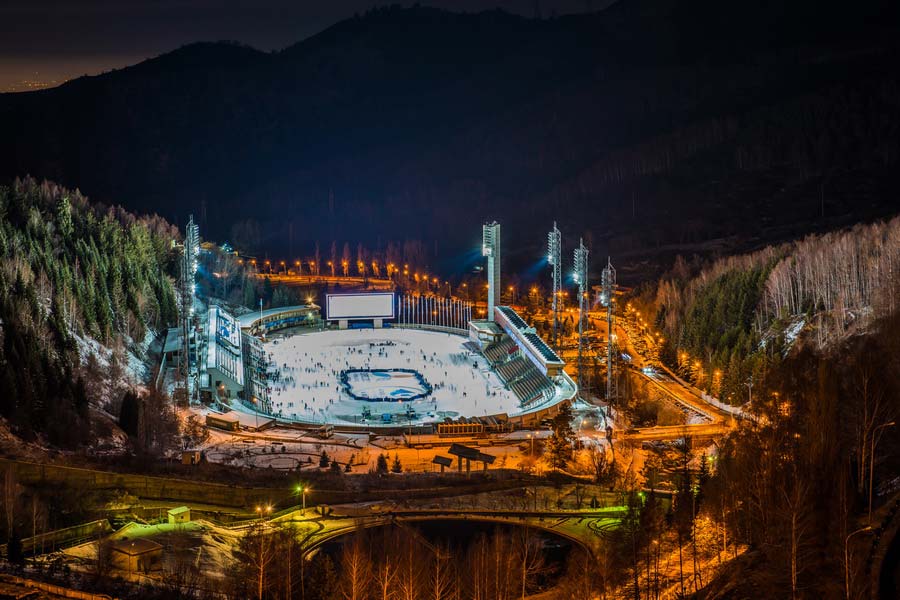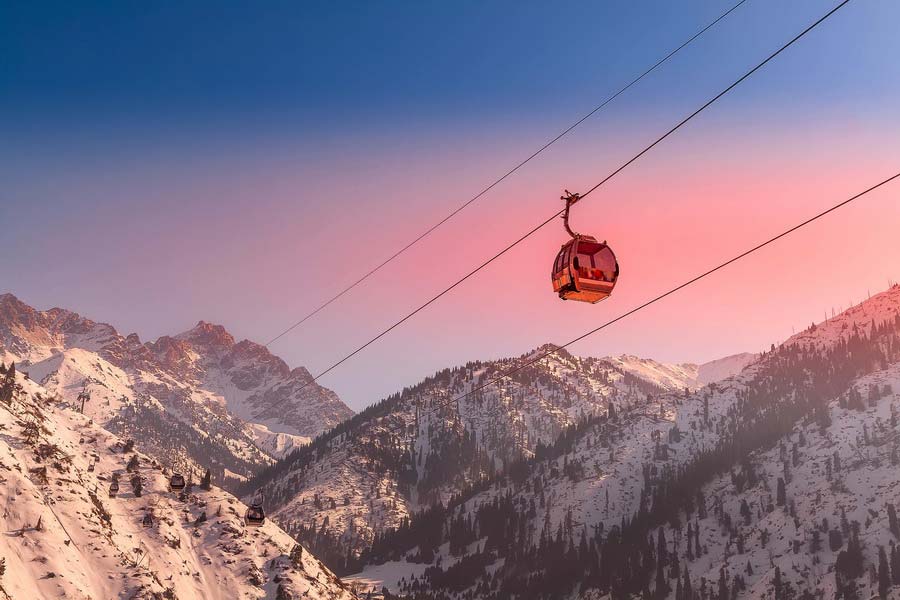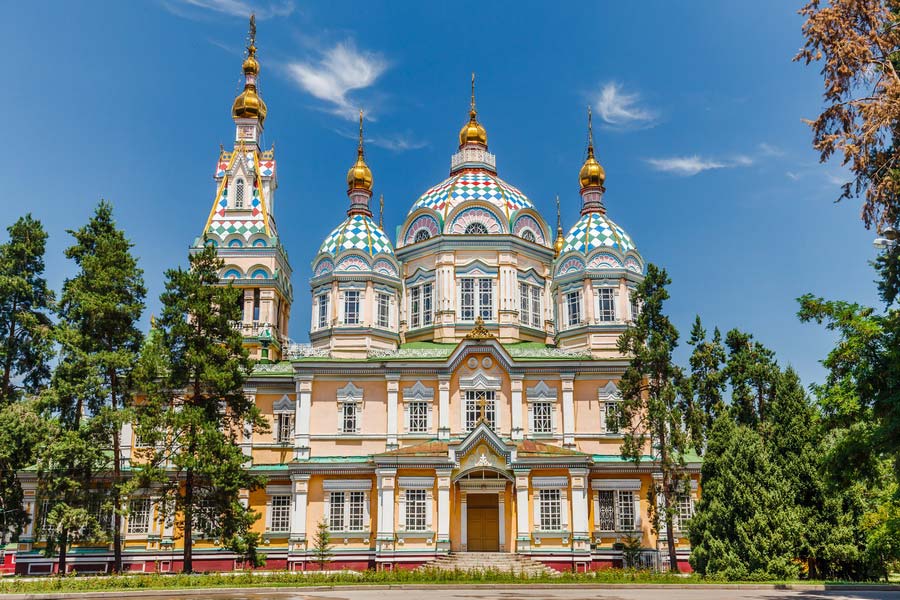Almaty, Kazakhstan

Former names: Almatu, Zailiyskiy, Verniy, Alma-Ata
Elevation: 785 m
Popular languages: Kazakh, Russian
Population: 1 854 556 (2019), www.stat.gov.kz
Time zone: UTC+5
Phone code: +7 727
Zip code: 0500XX
Automobile codes: 02
Almaty is located in the southeast of Kazakhstan. Its population is 1.5 million. Although it has lost the status of capital, Almaty remains the largest financial, economic and cultural center of Central Asia. It accommodates numerous business centers, theaters, museums, art galleries, exhibition halls and countless modern entertainment complexes (ultra modern movie theaters, casinos, nightclubs, parks, restaurants, cafes and ect.)
Almaty was the capital of Kazakhstan from 1929 to 1998. It is one of the most beautiful cities in Kazakhstan with a population of 1,200,000, situated in the foothills of the Zailisky Alatau Mountains.
In the medieval era it was the Almatu locality, in 1854 the Zailiiskoe fortress, and from 1921 to 1993, Alma-Ata. After the Decree of the President of the Republic of Kazakhstan of October 20, 1997 "On the declaration of Akmola the capital of the RK" Almaty recieved the status of city of National importance and became the southern capital of the country, the largest national financial, scientific and cultural center. The Residence of the Head of State and Government remains here. Branches of food and light industries dominate the economy of the city and produce over 70% of products of industrial enterprise. Some machine-building and mechanical factories represent the heavy industry of Almaty.

Residents and guests of the southern capital have at their disposal 5 stadiums, a hippodrome, and the high-altitude Medeo sport complex, featuring a unique ice skating rink located at 1700 m above sea level. This is where world records have been set many times by the world's top skaters. On weekends Medeo is a popular skating area for residents and guests of Almaty. Almaty Central Stadium accommodates 32,000 people. Nearby is a venue for track and field athletes and a perfectly equipped winter swimming pool.
Mountainous areas the visiting card of Almaty. You can begin your acquaintance with them on a ride by cable car to the city's highest point, Kok-Tyube (Blue Hill), 1130 m above sea level. From here you can view a splendid panorama of the mountain ranges and the city. It is especially beautiful at night when Almaty is illuminated by glimmering lights. The cableway soars over the old part of the city, buried in gardens called Compote by locals. This area is so called because of the fruit names of streets located here: Cherry, Pear, Grape, etc. While riding the cablecar up the hill you can watch the lifestyle of local people almost as in an ethnographic museum. The Kok-Tyube hillside is topped by a 350 m TV tower. If counted from sea level, this tower is the world's tallest one; moreover, it's built in a seismically active area.

If you take a ride across the dam on the comfortable road, you will reach another pearl of Almaty, the Chimbulak ski resort, situated at a height of 2230 m. Near the resort hotel there is a 1500-m cableway which takes skiers to the Talgar Pass (3,163 m above sea level). From here begins a 3000 m downhill ski run.
From Chimbulak the road continues up to spots popular with mountain climbers and hikers, due to their technical alpine routes and the beauty of majestic views.
The scenic Butakovka Gorge contains a lovely waterfall, located at 1860 meters. It's a good place to plunge into a world of unexplored wilderness and to enjoy watching wild animals and birds. Nearby is an alpine sport and tourist center.
The Bolshaya Almatinka Gorge is far from the city and therefore less crowded. If you happen to go there, be sure to hike up to Big Almaty Lake at a height of 2510 m (30-40 m deep and 1.6 km across). Fresh alpine air, the constantly changing color of the lake and a splendid mountain vista attract hundreds of travelers on weekends. There is an astronomical observatory near the lake, with a hotel where you can relax and enjoy watching stars through a telescope.
From Big Almaty Lake a short trek will take you to the beaches of Lake Issyk-Kul in Kyrgyzstan. Those who love exotic and secluded places can be immersed in wilderness. Passing the Tuyuksu Gates, you will find yourself in the Mynzhylki Gorge (3040 m) beyond which small moraine lakes are scattered. Their waters reflect the peaks of Tuyuksu and the Iglu Tuyuksu glaciers.
Almaty can vie with the mountain cities of Dushanbe, Karakol, or Erevan. It is at the same latitude as the well-known cities of Calgary and Vladivostok.
The city occupies an area of over 170 square kilometres. It stands on old and young deposits left by the rivers Bolshaya and Malaya Almatinka and their tributaries, running down from the Trans-Ili Alatau glaciers and ravines to the Ili Valley (Balkhash Lake Basin). Mountain rivers and lakes are the main source of water supply to the city. In the mountain gorges, there are many waterfalls, and thermal radon and sulphuric sources used as the basis for balneological spas.
On the outskirts of the city, were constructed mountain scientific stations designed to study the Sun and cosmic rays at Bolshoi Almaty Lakeand the Zhusaly-Kezen Pass, astrophysical observatories at the Kamenski Plateau and the Assy Pass, sports complexes at the skating stadium Medeu and the mountain ski resort Shymbulak, mountaineering and tourist camps, health resorts, holiday homes, and campgrounds.
Talgar (5017 m), Komsomol (today's Nursultan 4376 m), and Bolshoi Almatinski (3684 m) peaks prevail over the range of picturesque summits surrounding the city from the south. Some summits, rising beyond the clouds, are as high as European Mont Blanc, Caucasian Kazbek, and American Tajumulco.
The climate in the city is markedly continental, with considerable fluctuations in temperature, not only between different seasons, but also between day and night. From a height of 500 meters, the streets lead to the north, to the steppe and semi-desert, approaching the hot Kaskelen Moyunkuins. In the southern residential areas, at an altitude of 1520-1750 meters above sea level, in the Medeu Tract and the Kamenski Plateau, you can feel the breath from glaciers of the "mountain Arctic".
The average annual wind speed is half as much as in Moscow. Average temperature in July is the same as on the islands of Sri Lanka (Ceylon), Kalimantan (Borneo), or Java, and the average temperature in January can be compared with that in the north of Norway.
The amount of sunshine is high, up to 1596 hours a year; there are up to 151 frost-free days. Considerable is the level of air temperature fluctuation at different elevations: at the level of over 1400 meters, the average annual air temperature drops by 0.66° every 100 meters. These and other favourable natural and climatic factors provide unique opportunities for the promotion of sport and tourism.
Rich and diverse is the animal and vegetable kingdom of the Trans-Ili Alatau. The environs of Almaty are part of the Ili-Alatau National Park, on the territory of which nature reserves have been established. They are the habitat of many rare birds and animals now entered in the Red Book of Kazakhstan. Among them is the snow leopard, which at present embellishes the emblem of Almaty.
At the foothills of the mountains, grain, melon and gourd, and tobacco plantations and vineyards give way to orchards and berry fields. It was here that the celebrated Almaty aporto apple was first cultivated. Once this very apple was the symbol of the old town which gave it its name ("alma" is the Kazakh word for "apple").
Higher in the foothills (locally known as "counters"), wild apples, hawthorn, and apricots grow. In the mid-mountains, deciduous trees and shrubs give way to the shapely Tien Shan firs. Still higher, the mountains are covered with sub-alpine and alpine meadows, splendid summer pastures ("jailau") eventually becoming mountain tundra and finally reaching the realm of rock and eternal ice.
Gardens and parks, public gardens and boulevards occupy over 8 hectares of city territory. Among the green tracts grow exotic plants brought from North America, the Crimea, the Caucasus, Siberia, and the Far East.
The environs of Almaty can boast rare representatives of the local endemic flora, such as juno, anemone, hawthorn, and oxitropis. Long forgotten names of our countrymen, pioneers, and modernizers of this land live on in the names of many Almaty plants: Kolpakovski Xiphion, Nedzvetski apple, Fetisov onion, Dublitski hieracium, Schrenk fir, Regel Eremurus, Korolkov saffron, etc.
Many names of honorary citizens have been preserved in the names of mountains and valleys of the Trans-Ili Alatau: Palgov, Bryzgalov, Dmitriev, Poyarkov, Shnitnikov and Wojcehowski glaciers; Ryskul Valley: Kolokolnikov, Zimin and Kuderin summits; the city lexicon still has Baum Grove, Verigin Mount, Pugasov Bridge, Moiseyev Orchards etc. At present, however, the majority of the old names have been considerably changed and distorted.
Early in the 20th century, the writer P. X. Krasnov wrote: "in her witty stories, Teffi noted not without humor that every city is famous for something. Dresden is famous for Madonna, New York for the Statue of Liberty and Verny for its apples and earthquakes." It was also famous for its picturesque "counters" one of which was named after the distinguished citizen, Verigin.
One of the brilliant projects of architect A.P. Sokolov-Zeman, which was left unfinished, provided for the construction of terraces of public buildings on the slopes of the famous Verigin Mount (now Koktyube) and the erection of a monumental House of the Supreme Soviet of the Republic on its ridge top. The project was only implemented in one respect: they built the Palace of the Republic on Abai Square. There is a powerful radio and television transmission station with a 372-meter television tower constructed at the top of the mountain. Together with the mountain, the total height of the structure comes to 1402 meters above sea level. The mountain slopes are a favorite rest place for Almaty residents attracted by sledding and ski routes in winter, and green flowering lawns in summer.
You can easily ride to the top of Koktyube by cable car. Strolling around this picturesque spot, which provides a panoramic view of the "southern capital", you can observe the life of the big city. In small cafes, you will be offered a taste of the aromatic dishes of Kazakh national cuisine. From this place, you can also take excursions around the neighboring mountains and valleys.
Perching themselves at sweetly smelling easels amidst different varieties of grasses, red and bluish poppies, local snowdrops, and crimson peonies, which Almaty dwellers call Marja Korevna, local artists have strived to create their small masterpieces. Such were Nikolai Khludov ("On the Summit", 1886), Abylkhan Kasteyev ("View of Malaya Stanitsa", 1937), Aubakir Ismailov ("Alatau Valley", 1942), Yevgeni Sodorkin ("Queue at the Cable Railway", 1970), Dmitri Kalachev ("New TV Tower", 1982).
Verigin Mount and its environs were represented in the first films about our city. Well remembered are the films "Our Dear Doctor" (1957) produced by Sh. K. Aimanov, "Welcome to Alma-Ata" (1975) by A. G. Nugmanov, "Mountains and the City" (1976) by Ya. B. Sika, "Lights of Evening Alma-Ata", "City of Apple orchards", and "Alma-Ata" (1978-1981) by V. P. Tatenko.
It was here that, charmed by the view of the Trans-Ili Mountains and the steppe mirages of the Apple-tree Valley, the composers B. Yerzakovich and S. Shabelski, in association with the poets D. Abilev and A. Lukashenko, wrote the wonderful songs "Alma-Ata" and "My City" in 1948. It was here that Aset Beiseuov created his waltz "Ahnaly Almatym". Poetic feelings would overwhelm poets Dmitri Snegin in his poem "My City" (1939) and Tair Zharokov in his poem "The Torrent" (1937). Gifted Lines regarding Alma-Ata would also come to Yuri Platonov and Alexei Bragin, Dmitri Furmanov and Yuri Dombrovski as they cast a bird's eye glance at the city from the top of the mountain.

Almaty's unique natural and climatic conditions influenced courageous scientific ideas, engineering concepts, and projects of the century. Here the ideas of scientist V. N. Buchman relating to the utilization of solar energywere tested. The helio-therapeutic reflector which he invented and presented at the exhibition held to mark the 15th anniversary of the Kazakh Soviet Socialist Republic would boil water and put into action a small steam machine before the very eyes of the amazed public. The Buchman sun-dial embellished the square in front of the Cathedral. As regards Buchman's reflector, its salutary effect has been experienced since 1959 by patients of the first ever helio-clinic in the Republic.
It was in the surroundings of Almaty that Academician G. A. Tikhov originated astrobotany, a specific scientific trend concerned with studying the spectrophotometric properties of the surface of Mars and terrestrial vegetation. On this occasion, poets asserted that "there will be apple trees blooming on Mars" and none except Almaty aporto.
In 1906, Verny saw the publication of the anthology of the Utopian thinker N. F. Fyodorov under the general title "Philosophy of the Common Cause". The book had been prepared by Fyodorov's disciple, the Verny lawyer N. P. Peterson. This work by the representative of Russian cosmism Nikolai Fyodorov has been internationally recognized as a monument of philosophic thought. The philosopher predicted that there would come a time of immorality and a utilitarian approach towards the monuments of human civilization. Something similar has unfortunately happened in our city, where the past failed to live in harmony with the present and many monuments and historic places were not preserved.
Study of the Verny earthquakes initiated the formation and development of a new science of seismology and practices of earthquake-proof engineering in Kazakhstan. Two geological catastrophes are known to have taken place on 28 May 1887 and 22 December 1910 (old Russian calendar), as well as a destructive mud-and-rock flow which buried the city on the night of 8 and 9 July 1921. These events had a considerable effect on the development of the city's planning and the architectural appearance of the "southern capital".
In order to protect the city against possible mud-and-rock flows and floods, protective structures were erected on the rivers Bolshaya and Malaya Almatinka and their tributaries; in 1973, the Kazglavselzashchita Construction and Operations Agency was established.
By Vladimir Proskurin
Sister Cities to Almaty:
- Alexandria, Egypt
- Taegu, South Korea
- Istanbul, Turkey
- Tel-Aviv, Israel
- Rennes, France
